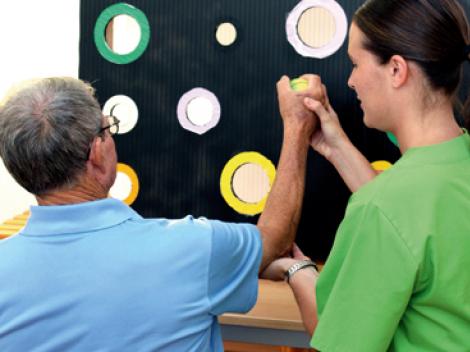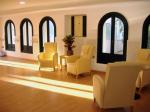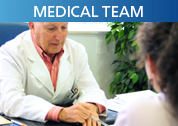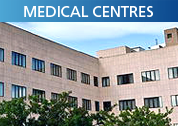


Spinal Disease
The spinal cord is the part of the central nervous system that is contained within the spinal column. Its integrity is fundamental for sending commands from the brain to the organs involved (limb muscles) and for sending sensitive information from the limbs to the central nervous system. It is involved in controlling independent or autonomous functions of the central nervous system, in sphincter control (bladder and rectum) and sexual function. Because the spinal cord is so fine, even minor injuries can have devastating consequences.
The most frequent symptom is loss of movement in areas of the body below the injury site. So, if the injury is at neck level, the patient is unable to move their four limbs (known full or partial tetraplegia, depending on the severity) and in the case of back injury, the patient is unable to move both legs (known as full or partial paraplegia). In the case of upper back injury, partial tetraplegia may be accompanied by weakness in the muscles needed for breathing, and the patient may require mechanical ventilation to help them breathe. Malfunction of the autonomous (or visceral) nervous system (ANS) causes intestinal disorders (constipation), problems urinating (neurogenic bladder, incontinence) and impotence.
Treating these after-effects requires specific neurological rehabilitation such as the treatment provided at the CASAVERDE NEUROLOGICAL REHABILITATION CENTRE.
Rehabilitation treatment
The treatment programme is based on neuro-rehabilitation techniques adapted to suit each patient's individual circumstances and aimed at enabling them to recover as fully as possible. The rehabilitation team meets regularly to set shared objectives and exchange useful information, ensuring excellent quality treatment. Below is a general description of the activities carried out by each of the medical specialities involved in the rehabilitation of people with neurological injuries:
Medical assessment: The Neurology Consultant and the Rehabilitation Consultant carry out an initial assessment and analysis of the reports compiled by the physiotherapy, occupational therapy, speech therapy and neuropsychology units.
This initial assessment is regularly reviewed and the treatment programmes implemented by the various units are continued or changed depending on the patient's progress.
Physiotherapy Unit
Initial assessment:
- Assessing the range of movement in the affected joint
- Muscle balance
- Modified Ashworth Scale (MAS) for assessing spasticity
- Tinetti Assessment Tool
- Berg Balance Scale (BBS)
- Sensitivity assessment
Planning and implementing treatment:
- Preventing damage associated with the neurological injury
- Treatment for deterioration in muscle tone
- Improving posture control
- Improving balance
- Treating problems with walking
- Treating for pain
- Aquatic physiotherapy
- Giving relatives advice on the proper way to handle the patient
Monitoring and progress:
- Progress is assessed regularly to review treatment objectives. When the highest possible degree of mobility has been recovered, doctors will suggest the patient is discharged.
Occupational Therapy Unit
Initial assessment:
- Chessington Occupational Therapy Neurological Assessment Battery (COTNAB)
- Loewenstein Occupational Therapy Cognitive Assessment (LOTCA)
- Motor Assessment Scale (MAS)
- Sensitivity assessment
- FIM + FAM (Functional Independence Measure + Functional Assessment Scale)
- The Barthel Index
Planning and implementing treatment:
- Treatment for impaired skills following the neurological injury
- Improving functionality of affected upper limbs
- Increasing independence in everyday activities and tasks
- Adapting the patient's environment
- Recommending technical aids
- Advice for families
- Vocational guidance / Rejoining the workplace
Monitoring and progress:
- Progress is assessed regularly to review treatment objectives. When the highest possible degree of functionality has been recovered, doctors will suggest the patient is discharged.
Speech Therapy Unit
Initial assessment:
- The Boston Diagnostic Aphasia Examination (BDAE)
- The Token Test
- Testing for Dysarthria
- Short Aphasia screening test
- Screening for swallowing disorders without bolus
- Screening for swallowing disorders using the volume-viscosity method of clinical examination
Planning and implementing treatment:
- Language retraining
- Speech retraining
- Retraining the swallowing reflex
- Voice therapy
- Mouth and facial stimulation
- AAC: Augmentative and/or Alternative Communication
Monitoring and progress:
- Progress is assessed regularly to review treatment objectives. When the highest possible degree of recovery has been attained, doctors will recommend the patient is discharged.
Neuropsychology Unit
Initial assessment:
- Clock drawing test
- Tracing test
- Hamilton Rating Scale for Depression
- Hamilton Rating Scale for Depression
- Integrated neuropsychology screening programme The Barcelona test
- Wechsler Adult Intelligence Scale WAIS-III
- Rey Complex Figure Test (RCFT)
- Complutense Verbal Learning Test for Spain (TAVEC)
- Benton Visual Retention Test
- Stroop Colour-Word Test
- Wisconsin Card Sorting Test (WCST)
- Rivermead Behavioural Memory Test (RBMT)
Planning and implementing treatment:
- Neurological rehabilitation
- Behaviour modification
- Emotional treatment
- Advice for families
Monitoring and progress:
- Progress is assessed regularly to review treatment objectives. When the highest possible degree of recovery has been attained, doctors will recommend the patient is discharged.
Criteria for Admission
Patients with acquired brain damage following:
- Head injury
- Acute cerebral haemorrhage
- Cerebral ischemic anoxia
- Benign brain tumours
- Meningitis and acute encephalitis
- Aged over 15
- With recent injuries
- Showing NO behaviour disorders or aggressive behaviour that may out other residents at risk and/or disturb normal relationships at the centre
- Showing no signs of infectious or contagious disease
- Clinically stable
Why come to the Neurological Rehabilitation Unit
- Because following brain injury, it is vital to receive specialist rehabilitation treatment as early as possible to have the best chance of making a full recovery.
- Because we believe that every person is unique and we are confident that they can make progress, however slight.
- Because we have a team of highly qualified professionals who have huge experience in treating these types of injury.
- Because we have the very latest technical equipment for treating neurological problems: transcranial magnetic stimulator (TMS), ICS balance platform and the AUPA Robot for upper limb rehabilitation, which we designed.
- Because we train our staff to ensure that care is based on a professional and human approach, catering for the needs of patients and their families.
- Because even when the patient cannot recover all their lost faculties, we can still work on giving them greater independence by using compensatory strategies.
- Because we not only treat the patient, we also take into account their family and home life so we can show them how to handle the patient correctly once they are at home. We also provide support and psychological help to enable everyone to adapt to their new situation.
- Because we give patients and their families information about how to access social assistance and other services they may need.
- Because all our facilities are specially designed for patient rehabilitation in adapted surroundings where patients and their families can feel at home, rather than in a stereotypical hospital environment. We offer extensive gardens, light and airy facilities, a pleasant temperature all year round, a welcoming atmosphere, countryside location, and much more.



